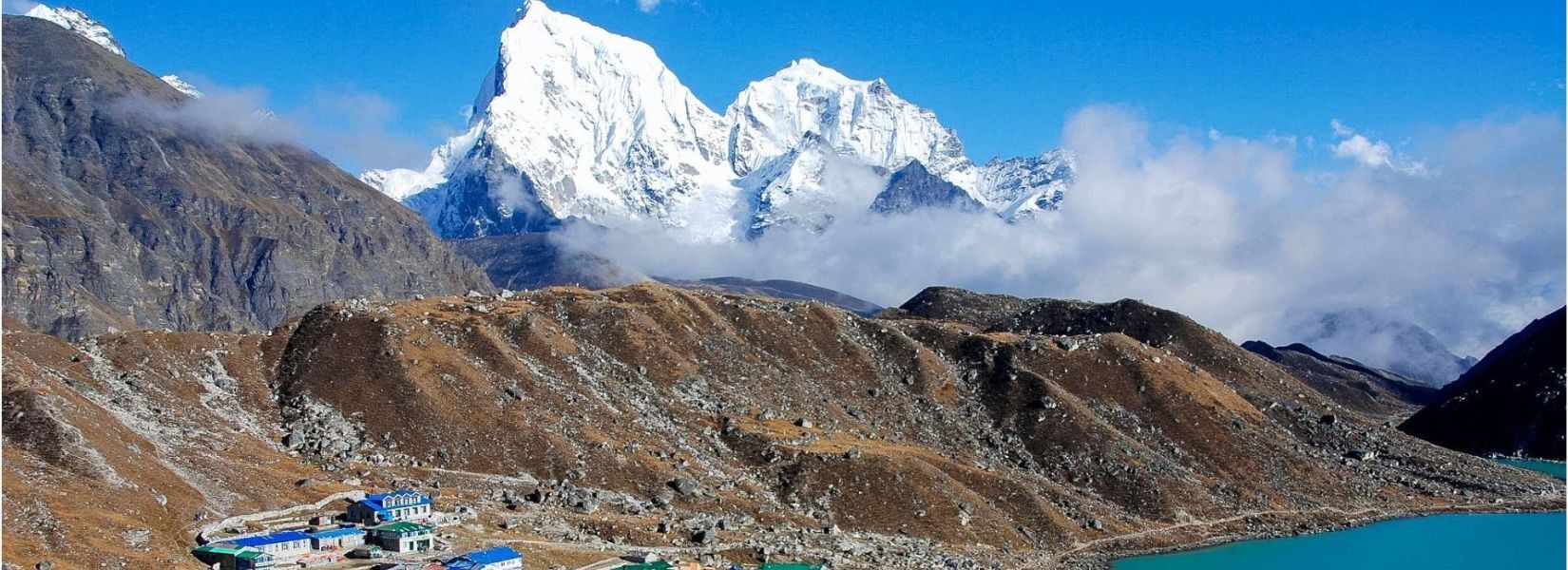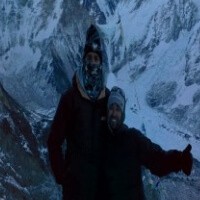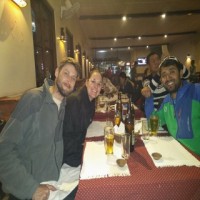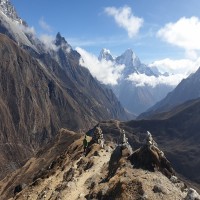The Everest Gokyo Cho La Pass Trek is an exciting 15-day hike. This trek combines the traditional Everest Base Camp Trek with the beautiful Gokyo Lakes and the challenging Cho La Pass. It is a unique opportunity to experience the natural beauty and culture of the Everest region. It's a dream trek for adventurers from all over the world.
It starts with a stunning flight from Kathmandu to Lukla. From Lukla, the trek takes you through beautiful Sherpa villages, dense forests, and dramatic landscapes. After that, an easy ascent to Namche Bazaar, the gateway to Everest. Here, you can acclimatize while experiencing the local Sherpa culture.
From Namche, you start your journey toward Everest Base Camp. During your trek, you will pass the Khumbu Glacier, the largest glacier in the Himalayas. You will also get to see an unforgettable sunrise view over Everest at Kala Patthar. This moment leaves trekkers in awe.
The trek also includes the adventurous Cho La Pass (5,420 meters). This high-altitude pass is challenging but incredibly rewarding. When you cross Cho La Pass, it becomes the highlight of your journey. The experience leaves you with a sense of accomplishment.
Another highlight of the trek is the peaceful and beautiful Gokyo Lakes. These bright green mountain lakes, surrounded by big peaks, are a sight to behold. Plus, taking a small detour to Gokyo Ri offers a stunning 360-degree panorama of Everest, Lhotse, Makalu, and Cho Oyu. These four mountains are among the world’s highest peaks above 8000 m. The trek through the Ngozumpa Glacier adds another layer of excitement to this already breathtaking adventure.
Throughout your trekking journey, you will experience the warm hospitality of the Sherpa people and get to explore their rich traditions. In addition, you will visit the beautiful Khumbu region. Here you will see colorful monasteries, prayer flags, and the feeling of spirituality in the air.
The best time to take this trek is during spring (March–May) or autumn (September–November). During spring and autumn, the weather is clear and the landscapes are at their most vibrant.
By the end of this remarkable journey, you will have walked through some of the world’s most stunning landscapes. You will also have crossed a challenging high-altitude pass. In the end, you are left with memories that will last your lifetime. This trek is more than just a hike, it’s an adventure that redefines the way you see nature and yourself.
- Destination: Nepal
- Trip Difficulty: Strenuous
- Trip Style: Trekking and Tour
- Transport: Private Vehicle / Aeroplane
- Food: Breakfast+Lunch+Dinner
- Accommodation: Lodge to lodge
- Group Size: min 1
- Max Elevation: 5545
Highlights
Everest Gokyo Cho La Pass Trek Highlights
Begin your trip with a memorable flight that provides beautiful views of the Himalayan mountains.
Hike to Kala Patthar for amazing views of Everest, Lhotse, and the Khumbu Glacier.
Visit the lovely Gokyo Lake trek by the Ngozumpa Glacier, the longest glacier in the Himalayas.
Witness the panoramic views of the majestic Himalayan peaks when crossing the Cho La Pass (5,420m).
Hike to Gokyo Ri, a perfect viewpoint to see Everest, Cho Oyu, Lhotse, and Makalu.
Outline Itinerary
Day 01Fly to Lukla (2804 meters) Trek to Phakding (2610 meters) 3 hours.
Day 02Trek to Namche Bazaar (3441 meters) 6 hours.
Day 03Namche Bazaar Acclimatization Day.
Day 04Trek to Phortse Thanga (3680 meters) 5 hours.
Day 05Trek to Machherma (4470 meters). 5 hours.
Day 06Trek to Gokyo (4790 meters) 6 hours.
Day 07Trek to Gokyo Ri (5483 meters) and then Back to Gokyo. 5 hours.
Day 08Trek to Thangna (4500 meters) 4 hours.
Day 09Cross Cho La pass (5300 meters) and trek to Dzongla (4710 meters) in 7 hours.
Day 10Trek to Lobuche (4910 meters). 4 hours.
Day 11Trek to Everest Base Camp (5365 meters), then back to Gorak Shep. 7 hours.
Day 12Hike up to Kalapattar (5555 meters) early in the morning, then trek down to Periche (4200 meters). 7 hours.
Day 13Trek to Namche Bazaar (3441 meters) 6 hours
Day 14Trek to Lukla (2804 meters) 6 hours.
Day 15Flight back to Kathmandu. Rest Day in Kathmandu.
What to Expect
What's included
- Airport pick-up and drop-off are by private car/van/bus.
- Kathmandu-Lukla-Kathmandu / Ramechap-Lukla-Ramechap scenic flight.
- Full board meals during the trek (3 times/day: breakfast, lunch, and dinner).
- Teahouse accommodations on the trek.
- Seasonal fruits/snacks during the trek.
- The first Aid kit included a BP set with Oxi-meters.
- Expert, experienced, friendly guide and porter, as well as their food, accommodation, salary, equipment, and insurance.
- All permits and Tims (please bring a passport copy and photos).
- Government tax.
What's not included
- Travel insurance.
- Cold drinks, snacks, and personal equipment.
- Tips for guides, porters, and drivers.
- Any other expenses that are not mentioned in the Price Includes section.
Useful Information
Everest Gokyo Cho La Pass Trek Permit
When you go trekking in this exciting area, it's important to get the right permits. It ensures that your trek is both safe and compliant with the legal regulations of the region.
While trekking in this beautiful Everest base camp and Gokyo Lake via Cho La Pass regions, you must be well prepared with the Sagarmatha National Park and Khumbu Pasang Lhamu Rural Municipality permits. These permits are mandatory for trekkers and all the travellers considering this trek.
Trekking permits serve both as legal requirements and support for local communities. It also protects the environment while ensuring safe travel for trekkers.
Everest Gokyo Cho La Pass Trek Difficulty
The Everest Gokyo Cho La Pass Trek is an exciting adventure. However, it is one of the more difficult treks in the Everest region. Trekkers need to be prepared for the tough terrain, unpredictable weather, and high altitude. This trek is not for beginners, as it demands physical endurance, mental strength, and proper preparation.
One of the biggest challenges is the constant ups and downs on rough trails. Plus, the Cho La Pass, at 5,420 meters, is very challenging. It features steep climbs, icy paths, and freezing temperatures. This section requires extra caution and proper gear to avoid risks like frostbite.
Trekkers also face the challenge of high-altitude conditions. The thin air at elevations above 5,000 meters can lead to altitude sickness.
To complete this trek successfully, you need to stay fit, adjust to the altitude, and be ready for any situation. With proper preparation, you will enjoy stunning views and feel a sense of accomplishment that makes your effort worth it.
Altitude Sickness and Remedies
Altitude sickness is a major problem for trekkers, especially on high-altitude treks like the Everest Gokyo Cho La Pass Trek. It occurs due to low oxygen levels and reduced air pressure at high elevations. Anyone can be affected if proper precautions are not taken, no matter their age or fitness level.
Symptoms of Altitude Sickness:
• Headaches
• Nausea or vomiting
• Loss of appetite
• Fatigue or weakness
• Shortness of breath during exertion
• Dizziness or lightheadedness
• Insomnia or difficulty sleeping
• Swelling in hands, feet, or face
Prevention Tips:
• Ascend Slowly: A steady ascent allows your body to acclimate to the lower oxygen levels effectively. You must avoid rushing, especially above 3,000 meters.
• Stay Hydrated: Drink plenty of water and avoid alcohol or caffeine, as they can dehydrate you.
• Acclimatize Properly: Plan rest days during your trek to let your body adapt to higher altitudes.
• Eat Nutritious Food: A healthy diet provides essential nutrients for your body and helps fight fatigue.
• Carry Medication: Bringing Diamox or other altitude sickness medicines can help prevent or relieve symptoms.
• Listen to Your Body: If you notice symptoms, rest immediately or descend to a lower altitude.
Everest Gokyo Cho La Pass Trek Travel Insurance
If you want to hike the Everest Gokyo Cho La Pass, you need travel insurance. This demanding trail to Everest Gokyo Cho La Pass reaches 5,545 meters in altitude. With such high altitudes come risks like altitude sickness, accidents, sudden weather changes. So, the insurance coverage will ensure your safety during these unexpected situations.
What Your Travel Insurance Should Cover?
When purchasing travel insurance for this trek, ensure the policy includes the following essential coverage:
• Medical Expenses: The policy covers hospital stays, doctor visits, and treatments if you get injured or sick while trekking.
• Emergency Evacuation and Helicopter Rescue: In high-altitude treks, helicopters are often the best way to deliver medical aid during emergencies. For this reason, make sure the policy covers helicopter rescues up to 6,000 meters.
• Trip Cancellation or Interruption: Reimburses costs if your trip gets canceled due to unforeseen circumstances, like flight cancellations, political unrest, or personal emergencies.
• Loss or Theft of Luggage and Personal Belongings: Protects you from financial loss if your luggage or gear goes missing during the trip.
Important Tips for Choosing Insurance
• Altitude Coverage: Confirm that your policy specifically covers trekking at high altitudes (up to 6,000 meters).
• Emergency Support: Check if the insurance company provides round-the-clock assistance for emergencies.
• Verify Helicopter Rescue Coverage: Don’t just rely on website details; contact the insurance company to confirm helicopter evacuation is included.
• Submit Insurance Details Early: Many trekking agencies require you to provide proof of insurance before starting the trek.
Training for the Everest Gokyo Cho La Pass Trek
Training for the Everest Gokyo Cho La Pass Trek requires both physical and mental preparation because the trek is quite challenging. It’ll be a huge advantage to you if you began training at least 6 months prior to the start of your trek. You must work on your stamina, strength and endurance so that you can take on the challenging and tiring hikes for days.
Getting ready properly will help you handle tough trails and low oxygen levels. This preparation will also lower your chances of getting altitude sickness. Some of the major steps that you must consider including in your daily routine are:
• Cardio Fitness: Exercises like walking, jogging, cycling, running, stair climbing etc.
• Strength Training: Any exercises targeting your core and enhance your upper body and lower body strength like weight lifting, push-ups, pull-ups etc.
• Mental Preparation: Train your mind to push through challenges. Practice meditation, yogas and breath control to prepare yourself.
Everest Gokyo Cho La Pass Trek Best Time
Choosing the right season to trek to Gokyo Cho La Pass via the Everest Base Camp route is important. If you prefer colorful landscapes and warmer weather, spring is your best option. Or, If you like clear skies, calm paths, and bright autumn colors, choose the autumn season. Both seasons are great for trekking, but you should choose based on the experience you want.
Spring Season (March to May)
Spring is one of the most popular seasons for trekking the Gokyo Cho La Pass. The weather is mild, the environment is lively, and nature is at its best. The temperatures range between 1°C and 12°C at EBC, providing a pleasant climate for hiking. Plus, occasional cool breezes make it easier to tackle steep inclines. In April and May, there are longer daylight hours. This gives trekkers more time to enjoy their journey and set their own pace without feeling rushed. Plus, spring is a great time for mountain views. You can see stunning snow-covered peaks, like Mount Everest.
Autumn Season (September to November)
Autumn is another fantastic time for trekking. It offers stable weather, clear skies, and colorful landscapes. It is neither too hot nor too cold, making it ideal for hiking. There may be light rain in early September, but by mid-month, the weather improves and is great for trekking.
Food and Accommodation on Everest Gokyo Cho La Pass Trek
Teahouses along the Gokyo Cho La Pass trek provide basic yet satisfying meals and comfortable accommodations. Here’s what you can expect during your trek.
Food Availability
Food and meals on the Gokyo Chola Pass trek to Everest Base Camp are usually good. There are many small villages and tea houses along the way. These teahouses offer local dishes like dal bhat and momos, and simple Western food, such as pasta and pizza.
• Breakfast: Start your day with simple meals like pancakes, cornflakes, porridge, chapatti, toast, hash browns, muesli with milk, or local bread. These teahouses also serve a variety of egg dishes. You can find eggs fried, scrambled, boiled, or an omelet.
• Lunch and Dinner: The menu for lunch and dinner is quite similar. Trekkers can choose from Nepalese staples like dal bhat (rice, lentils, and vegetables) or indulge in more familiar Western options such as pasta, pizza, or momos (dumplings). Soups like tomato, mushroom, garlic, and chicken soup are perfect for warming up in the cooler evenings.
• Drinks: A variety of beverages are available to keep you hydrated and refreshed. You can enjoy black tea, ginger tea, mint tea, lemon tea, milk tea, or coffee (black or with milk).
While the meals are simple, they are nutritious and filling—ideal for the physically demanding trek.
Accommodation Facilities
Accommodation on the Gokyo Cho La Pass trek is primarily in teahouses, which are simple yet cozy lodging options that cater to trekkers.
• Teahouses: These teahouses typically have small rooms with two beds, a window, and plastered or wood-paneled walls. The beds are covered with foam mattresses and provide adequate comfort for the night.
• Heating: Most teahouses have a central burner in the common area, which is lit in the evenings to keep everyone warm. Some rooms may have individual heaters, but this is less common.
• Showers: Hot showers are available at certain teahouses, but not all. Where available, there may be a small fee for using the facility.
• Electricity and Charging: You can find charging points in most teahouses, but you may need to pay a small fee to charge your devices. It’s also a good idea to carry a power bank as a backup.
• Room Availability: During the busy trekking season, securing a single room can be challenging. However, double rooms are more commonly available. So, make sure you plan your trek accordingly.
A Few Tips for Trekkers:
• Bring Snacks: Even though teahouses offer meals, you should pack some high-energy snacks. Snacks like granola bars, nuts, or chocolates will provide you with enough energy during long trekking days.
• Stay Hydrated: Safe drinking water is essential. Consider using water purification tablets or bottles with built-in filters.
• Pack Light: All teahouses offer basic accommodation. You have to pack light with your daily essentials only. Include your sleeping bag, toilet rolls, and extra layers for cold nights.
Packing List for Everest Gokyo Cho La Pass Trek
The Gokyo Cho La trek is a very challenging hike for anyone. During this trek, you will cross difficult terrains and experience unpredictable weather patterns. So, the success of the trek greatly depends on having the right equipment. Therefore, make sure you bring what you need. You can also rent or purchase some of it in Kathmandu before you begin your trip to Lukla. Here’s a comprehensive list of what you’ll need:
Clothing
• Base Layers
• Fleece/Sweater
• Down Jacket
• Waterproof Jacket and Trousers
• Trekking Trousers
• Warm Gloves
• Socks
• Hat/Cap
Footwear
• Hiking Boots
• Camp Shoes
• Gaiters (Leg Protection)
Accessories
• Sunglasses
• Sun Cream and Lip Balm
• Trekking Poles
• Torch/Headlamp
• Sleeping Bag
Hydration and Hygiene
• Water Bottle
• Small Towel
• Hand Sanitizer and Toiletries
• Medical Kit
Frequently Asked Questions (FAQs)
What permits do I need for Everest Base Camp Trek?
The permits needed for the Everest Base Camp Trek are a Sagarmatha National Park entry permit and Khumbu Pasang Lhamu rural municipality entry permits. These are the two primary mandatory permits that you must achieve which can be obtained in Kathmandu at Nepal Tourism Board.
How much does it cost to go to Gokyo Ri Trek?
The cost of the Gokyo Ri Trek depends on various things such as the mode of transportation, accommodation, group size, permits, porter cost, trekking season etc. The Gokyo Ri Trek typically costs between USD 1,100 to USD 1,800 per person which can differ as per your requirements.
Can I trek to Everest Base Camp on my own?
As per the new regulations set by the Nepal Tourism Board effectively from the 1st of April 2023, you cannot trek to Everest Base Camp completely alone. It has been made mandatory to have a licensed guide, who will ensure safety and enhance your journey.
How difficult is the Gokyo Lakes trek?
The Gokyo Lakes trek is considered a moderately challenging trekking trail in the Everest region, which is achievable for trekkers with proper preparation. With the challenging journey, it offers spectacular mountain panoramas that will captivate your mind and sight.
What are the most challenging high passes on the EBC trek?
The most challenging high passes on the EBC trek are:
Kongma La Pass: Highest pass at 5,535 meters and considered as the most technically challenging pass.
Cho La Pass: Elevation of 5,420 meters and often considered as the hardest pass by most trekkers.
Renjo La Pass: Elevation of 5,360 meters with the most scenic and panoramic himalayan views.












